Innovative Ways to Divide Rooms Without Walls


Intro
In today's dynamic living environments, the traditional notion of separate rooms is evolving. Homeowners and renters alike are increasingly seeking ways to utilize space more effectively, and dividing rooms without erecting physical walls is a compelling solution. This approach not only enhances the functionality of a given area but also offers aesthetic appeal. Whether for creating a cozy reading nook or designating a workspace, non-traditional divisions can reshape how we experience our homes. The following sections will provide insights into design techniques, practical implementations, and current aesthetic trends that can guide one in creating a multifaceted living space.
Design Inspiration
Current Interior Design Trends
The trend towards open-concept living is no longer a fleeting phase; it is a permanent shift in design philosophy. More homeowners are recognizing that open spaces foster connectivity and engagement among inhabitants. However, as some seek to maintain a sense of intimacy and privacy, innovative design methods are rising to the forefront. Elements such as acoustic panels, shoji screens, and furniture arrangements can effectively create zones within a larger space while retaining an open feel.
Implementing plants like faux trees or hanging greenery can also act as a natural divider, providing both visual and psychological separation. When selecting dividing elements, consider using transparent materials like glass or open shelving units that maintain airflow and encourage light distribution. These conscious design choices reflect a growing awareness of the need for balance between openness and structure in modern home design.
Color Palettes and Their Effects
Colors have significant effects on mood and perception. Choosing the right color palette can enhance the feel of each section of your space. For instance, neutral tones like beige, gray, or soft whites can promote relaxation and visual harmony, making areas feel cohesive despite being functionally different. While warmer colors such as yellow or soft orange can energize a space, often making it feel more inviting, it can also create a distinct area that feels separate yet connected to the broader environment.
This year, trends also lean toward bold accent walls or textured finishes which can guide the eye and designate areas without solid barriers. Consider choosing a soft or muted color for the main areas and using vibrant hues selectively to differentiate spaces or highlight specific zones.
"Color can be almost ethereal; it creates atmosphere, influences mood, and can be used to delineate spaces without physical barriers."
Overall, effective interior design is about understanding how elements interact with one another to create both function and comfort, especially in open spaces without traditional walls.
Practical Solutions
Furniture Arrangement
Arranging furniture thoughtfully is fundamental in dividing spaces without using physical barriers. A sectional sofa can act as a backrest, creating a distinct area for relaxation while leaving sight lines open to the rest of the room. Using area rugs to define different sections can also signal purpose. For example, a dining table set on a rug can visually separate the eating area from a adjacent living space.
Placing furniture at angles rather than in straight lines can also encourage movement and interaction. Ottomans, benches, and foldable tables can provide flexible solutions that adapt to the needs of the moment.
Use of Partitions and Screens
Partitions and screens are versatile options for division. They can be moved based on need and are available in various styles, materials, and heights. For contemporary aesthetics, consider plexiglass or metal partitions; for a softer touch, fabric or wood screens can bring warmth._ These additions allow one to create defined areas while maintaining a level of openness that rigid walls do not permit._
Preface to Open Space Concepts
Open space concepts have become increasingly relevant in modern interior design. This section examines the essence of open living and highlights the significance of effectively dividing spaces without traditional walls.
Understanding Open Living
Open living is a design approach that emphasizes fluidity between spaces within a home. It seeks to eliminate barriers, allowing for greater interaction among occupants. Traditional rooms often limit social interactions and can create a sense of isolation. By removing physical boundaries, households can benefit from a more cohesive experience. For example, an open floor plan connects the kitchen, dining area, and living room. This can encourage family gatherings and enhance communication, fostering a sense of community. In addition, open living spaces can be visually larger, making environments feel more expansive than they might be with segmented layouts.
Importance of Space Optimization
Effective space optimization is crucial for functionality in both small and large environments. When dealing with limited square footage, maximizing available space becomes essential. Savvy homeowners and renters should consider how to use their space wisely without losing aesthetic appeal. Creating designated areas for different activities, like work or leisure, becomes feasible without adding permanent walls. This promotes flexibility in usage, allowing residents to adapt their environments as needed.
Moreover, optimizing space involves thoughtful organization. Strategic placement of furniture and accessories can lead to improved flow and accessibility. By focusing on these elements, one can transform a single area into multiple functional zones.
Open space concepts not only enhance livability but can also contribute to reducing stress by creating a more inviting atmosphere.
Assessing Your Space
Assessing your space is a crucial first step in the process of dividing rooms without walls. This stage involves careful consideration of how the available area is currently utilized and how it can be optimized. Recognizing the dimensions of your room helps in visualizing any changes you might want to make. Accurate measurements allow you to determine the placement of furniture and other dividers effectively. Additionally, it is essential to understand the flow of movement through the areas you aim to define.
Some benefits of assessing your space include:
- Customization: Tailoring your layout based on genuine measurements and needs.
- Efficiency: Maximizing the utility of every square foot.
- Flexibility: Enabling easier adaptations in style and function if necessary.
Measuring Your Area
Measuring your area involves more than just noting the dimensions. It lays the groundwork for every decision you will make later. To start, grab a measuring tape and follow these steps:
- Measure the length and width of the room. This gives you a clear understanding of total square footage.
- Consider vertical space too. High ceilings may allow for vertical dividers like bookshelves or plants.
- Note structural features such as windows and doors, as these will affect placement and layout.
These details provide a comprehensive view of your room's layout.
Identifying Functional Zones
Once you have the measurements in hand, the next step is identifying functional zones within your space. This involves determining various activities that will take place in each designated area.
For instance:
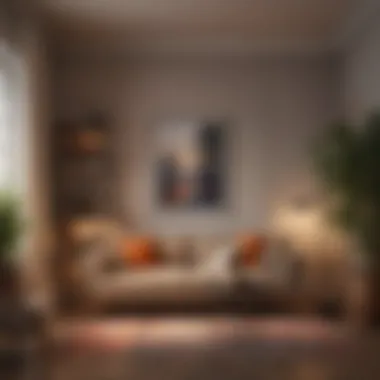
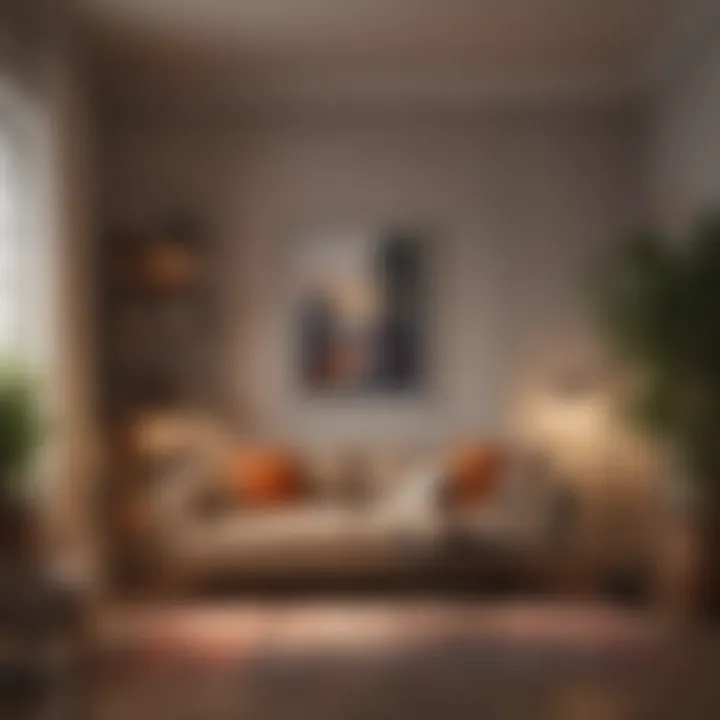
- A living area may require a relaxing zone versus an entertainment area.
- A dining area needs to be near the kitchen for convenience.
- A home office zone should be more secluded for better focus.
When establishing these zones, keep the following in mind:
- Flow: Movement between areas should feel natural.
- Purpose: Define each zone based specifically on intended use.
- Balance: Ensure that no one area overwhelms others, creating an overall harmonious environment.
Assessing your space thoroughly before implementing design changes equips you with the critical insights needed for successful room division without walls, ultimately leading to a well-organized and functional environment.
Utilizing Furniture
The way furniture is arranged can significantly impact the flow and feel of a space. In an open layout, effective utilization of furniture becomes an essential strategy for creating distinct areas without erecting physical walls. This section delves into various approaches to furniture arrangement, demonstrating how these methods can enhance both functionality and aesthetics in your home.
Strategic Arrangement of Seating
The placement of seating can either promote conversation or create a sense of separation. By arranging couches and chairs in a circular or semi-circular fashion, you can foster interactions among family members and guests. Conversely, positioning furniture with backs facing each other can segment areas effectively within larger spaces. Consider also the height of the furniture; low-profile seating can maintain an open feel, while taller pieces introduce a sense of intimacy and privacy. When selecting materials, choose soft textures that invite relaxation, further enhancing comfort while defining different zones. Explore sectional sofas, as they provide versatility and can be arranged to suit numerous configurations.
Incorporating Multi-Functional Pieces
In an age where space is a premium, multi-functional furniture is more relevant than ever. Items such as ottomans that double as storage or coffee tables that convert into dining surfaces greatly contribute to space efficiency. Look for furniture that adapts to your lifestyle needs; for instance, a sofa bed can transform a living room into a guest area with ease. This flexibility allows for seamless transitions between daily activities and entertaining guests. Additionally, multi-functional pieces minimize clutter, keeping environments tidy yet stylish. Overall, these items are invaluable for anyone looking to optimize their living space without compromising on style.
Using Rugs to Define Areas
Rugs serve both aesthetic and practical purposes in an open space. They can delineate different functional areas, such as separating a dining area from a living space. A well-chosen rug can anchor a space and create a visual boundary without requiring solid walls. When selecting a rug, consider scale and color. A large rug can unify an entire room while smaller rugs can highlight specific corners or functions. Furthermore, textures play a role in the overall experience; a plush rug underfoot can offer comfort, inviting more use of the designated area.
"Rugs can create a homely feel and visually separate areas, making them critical in open space design."
By integrating these strategies surrounding furniture use, you can effectively manipulate your space for both utility and comfort. Approaching the arrangement of furniture with intention can lead to a more organized environment that suits the lifestyle of homeowners, interior design enthusiasts, and social hosts alike.
Open Shelving Solutions
Open shelving represents a practical and aesthetic approach to dividing spaces without traditional barriers. This method combines functionality with style, enabling homeowners to create both visual and physical separation between areas in an open layout. As modern living spaces become increasingly open-concept, the need for efficient room division grows.
Open shelving units can serve many purposes beyond mere storage. They allow for displaying decorative items, books, or personal collections while keeping spaces organized. By using shelving, you can add an inviting atmosphere that encourages interaction without overwhelming the design with dense furnishings. This method is particularly effective in smaller apartments or homes, where every square inch counts.
In addition to enhancing aesthetics, open shelves can be strategically placed to guide movement and create zones. This approach helps delineate areas like the kitchen from the dining room or the living room from a workspace. Moreover, open shelving offers versatility, as its arrangement can be easily adjusted according to changing needs or preferences.
Creating Visual Divisions
Visual separation is crucial in designing open spaces. Open shelves can effectively create these divisions without hindering light flow, which is vital in maintaining a spacious feel. When used as dividers, shelves provide a sense of coziness while still allowing sightlines across the room. Selecting the right type of shelving is important—some may opt for minimalist designs, while others prefer more decorative options that add character.
Consider varying the heights, styles, and objects displayed on the shelves to create interest. For instance, taller shelves can create a statement, while lower ones can offer a more approachable feel. Using materials like wood or metal can contrast textures, enriching the space visually.
This method not only defines spaces but also encourages a narrative through the items placed on shelves. Using meaningful decor can connect personal stories, making your space feel uniquely yours.
Maximizing Storage While Segregating Space
Open shelving is not just about aesthetics; it's also an opportunity to enhance storage solutions effectively. By incorporating shelving into your design, you can maximize vertical space, which is often underutilized. This is especially relevant in areas like kitchens, where storage can become chaotic without proper organization.
To achieve optimal use of open shelves:
- Categorize Items: Group similar items together. This creates a systematic look that is easy to navigate.
- Utilize Bins and Baskets: These can hold smaller items and maintain a tidy appearance while still being easily accessible.
- Rotate Items Seasonally: Periodically changing what’s on display can refresh the space and keep the organization effective.
- Incorporate Lighting: Adding small lights can highlight certain areas and bring warmth to and enhance the visual appeal.
Ultimately, combining form and function is key. Open shelving allows you to create efficient storage solutions while effectively dividing spaces. This method caters to both practical needs and aesthetic desires, making it a fitting choice for those looking to maintain an organized yet stylish environment.
Using Curtains and Drapes
In an open space design, curtains and drapes emerge as a vital element. They serve not only as aesthetic enhancements but also as functional dividers. Undoubtedly, these textile solutions create visual separations without the permanence of walls.
Curtains offer flexibility in how you manage your space. This flexibility is especially valuable in environments with fluctuating needs. For instance, a large living area can transform into a cozy nook simply by drawing closed a few panels. Options range from sheer to blackout materials, allowing for control over light and privacy.
There are specific benefits to consider when incorporating curtains and drapes into your design.
- Cost-Effectiveness: Unlike walls or permanent structures, curtains are relatively inexpensive. They usually require minimal installation, making them an affordable option for renters.
- Design Versatility: From bold patterns to subdued shades, curtains can complement any decorating scheme. Textiles can establish a mood, whether you want a vibrant look or a calmer palette.
- Seasonal Adjustments: Changing curtains or drapes seasonally can refresh a space with minimal effort. This practice allows homeowners to adapt to changing trends or personal preferences.
However, there are considerations to keep in mind. Heavy drapes might close off space and reduce light, while sheer curtains may lack the privacy some may desire. Assessing these factors is crucial in achieving a balance between openness and seclusion.
Flexible Room Dividers
Usign curtains as flexible dividers effectively manages large areas. Different styles of curtains can be selectively drawn to modulate spaces based on current needs. For example, during a family gathering, you might prefer an open layout, but once the guests leave, you may want some privacy. Choosing a curtain rod that allows for easy movement is essential for this purpose. Look for options that can support heavy fabrics without sagging.
Creating Ambiance with Textiles
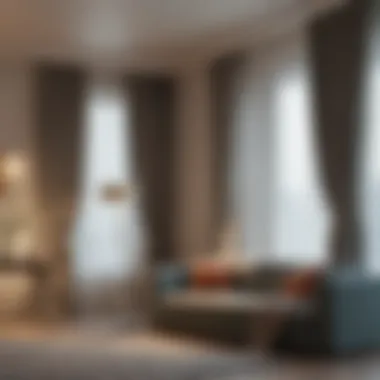
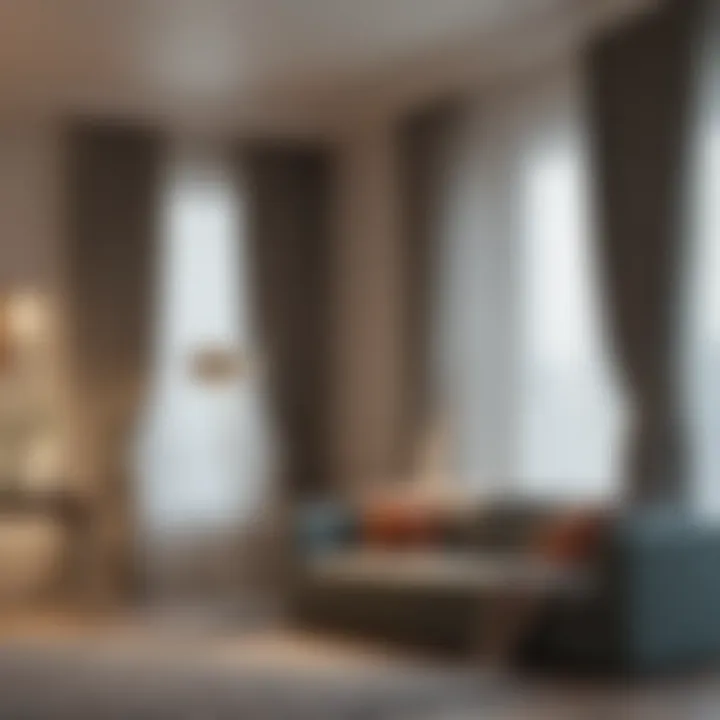
The use of curtains and drapes can also enhance the room's ambiance. Fabric texture and color play an important role in setting the tone. Soft, flowing fabrics can add warmth, while crisp, structured options might foster a sense of modernity.
Using textiles to reflect your personal style allows for a unique touch in your space. Consider layering curtains of different lengths or using tie-backs to adjust openness throughout the day. Such tactics can help create a comfortable yet stylish environment.
"Curtains are not just fabric; they can be a game-changer in how we perceive our living spaces."
Investing in Sliding or Folding Screens
Sliding and folding screens serve as functional and aesthetic solutions for those looking to segment space without the permanence of traditional walls. They offer a practical means to create separate areas without altering the room’s architecture. By utilizing these screens, homeowners and renters alike can achieve flexibility in how they use their space.
These screens provide an excellent alternative for those who may not own their property or want to avoid extensive renovations. They can simply be moved or removed, allowing for adaptations based on changing needs.
Types of Screens Available
There are several types of sliding and folding screens available for purchase, each with unique characteristics suited to different space requirements. Some of the most common types include:
- Bi-fold Screens: These can fold in half and are ideal for larger openings. They allow for flexible space division while ensuring easy passage from one area to another.
- Sliding Panels: Mounted on tracks, these panels glide smoothly and can completely open up or close off spaces. This design works well for dressing areas or dividing a living room from a dining space.
- Room Dividers on Wheels: These mobile solutions can be easily relocated as desired. They come in various materials, from fabric to wood, and can offer a quick solution for temporal partitions.
- Accordion Screens: Similar to bi-fold screens, these can expand and contract but with multiple folds. They are efficient in saving space when not in use.
Each type presents its own set of characteristics, and selecting the right one depends on factors like aesthetic preference, functionality, and how frequently the space will be reconfigured.
Benefits of Movable Partitions
Investing in movable partitions provides numerous benefits that enhance both the practicality and aesthetic appeal of a space. Some notable advantages include:
- Flexibility: These screens can be adjusted according to current needs. For instance, they can open up for gatherings or close off for quiet time, adapting to various situations easily.
- Space Efficiency: Movable partitions maximize functionality without permanently consuming square footage in a room. They keep spaces open and airy when desired but allow for separation when needed.
- Aesthetic Appeal: Available in various designs, colors, and materials, sliding and folding screens contribute to the interior aesthetics. They can act as a design statement while still being functional.
"Flexible room dividers enable you to maintain an open feel while also accommodating different activities and privacy needs."
- Cost-Effective Solution: Compared to building actual walls, these screens offer a more affordable option for space division. They require less time and effort to install and can be modified as your tastes or needs evolve.
Designing with Architectural Elements
Incorporating architectural elements can dramatically influence the way spaces are perceived and utilized. It transcends the need for traditional barriers by redefining boundaries within a shared area. These elements not only enhance visual appeal but also serve practical purposes that contribute to the overall function of a space. In this section, we explore two primary methods of utilizing architectural features to achieve an organized and aesthetically pleasing environment.
Incorporating Half-Walls
Half-walls, or half-partitions, serve as an effective means of dividing spaces while allowing light and sightlines to remain intact. They are not as imposing as full walls, yet they still create a sense of separation. This can be particularly beneficial in open-plan layouts, where delineating areas such as dining and living spaces is essential. The benefits include:
- Enhanced Light Flow: Half-walls maintain an airy feeling by allowing natural light to filter through.
- Visual Connection: They create a sense of openness while providing some privacy, which can make a large space feel cozier.
- Versatile Usage: Half-walls can be used functionally as shelves or surfaces for decorative items, further integrating style into its purpose.
When considering half-walls, ensure they match the overall decor. Material choices can vary from wood to glass, depending on the desired effect. This component can establish a visual rhythm that enhances the flow of the environment without overwhelming it.
Using Columns and Beams for Separation
Columns and beams are fundamental architectural elements that can be strategically placed to delineate space. Unlike conventional walls, these features can be designed to be both load-bearing and visually appealing. Utilizing columns and beams allows homeowners to define areas without dismantling the open concept.
Key considerations for using columns and beams include:
- Alignment with Structural Integrity: Always assess the structural requirements before adding or modifying columns or beams to ensure safety and compliance.
- Design Cohesion: Make sure these elements harmonize with the existing design. A well-planned column can serve as a statement piece while providing functionality.
- Varied Finish Options: Finishes can range from sleek modern styles to rustic textures, enhancing the overall character of the space.
Ultimately, incorporating architectural elements such as half-walls and columns not only divides rooms effectively but enhances the emotional appeal of the areas as well. They pave the way for creative spatial layouts that resonate with homeowners and design enthusiasts alike.
Exploring Color and Light
Color and light play a significant role in defining spaces, especially in open layouts where traditional walls are absent. The choices made in color palettes and the management of light can create an organized feel and help to separate areas visually without physical barriers. Understanding how color and light interact in your space can enhance both functionality and aesthetics.
Using Color to Create Boundaries
Color can be a powerful tool for creating partitions in a room. It allows for the delineation of different functional areas while maintaining an open feel. By choosing different paint colors for adjoining spaces, you can achieve a sense of separation.
- Contrast: Using contrasting colors can give distinct identities to various sections of a room. For example, a vibrant blue wall can contrast beautifully with a soft gray, signaling to the eye that these areas serve different purposes.
- Harmony: Alternatively, using shades of the same color can create a seamless transition between spaces. This approach allows for subtle division, which can be beneficial in multifunctional areas like a living room that also serves as a home office.
- Focus Areas: Bold colors can guide the eye to specific areas of interest, such as a reading nook painted in a warm, inviting tone. This draws attention and encourages certain activities, contributing to the functionality of the space.
In addition to paint, consider using wallpaper or decals to introduce patterns and textures that can serve as visual markers without blocking the light or airflow.
Manipulating Natural Light
Natural light is another essential element in spatial organization. Proper use of light can visually open a space, encourage flow, and establish connections between different zones.
- Maximizing Light Sources: Place mirrors strategically to reflect light. This creates an illusion of depth and can brighten darker corners of an open space.
- Window Treatments: Choose sheer curtains or blinds that allow light to filter through while still providing an element of boundary. This can define areas without compromising brightness.
- Layering Light: Combine ambient, task, and accent lighting to enhance specific areas throughout your space. For example, pendant lights over a dining area can define it clearly from a living space.
The interplay of color and light should not be underestimated. Together, they define spatial boundaries and contribute to the overall atmosphere of your home, providing both function and style.
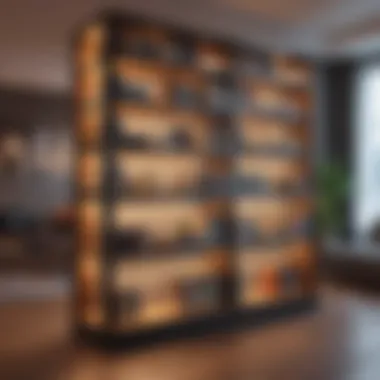
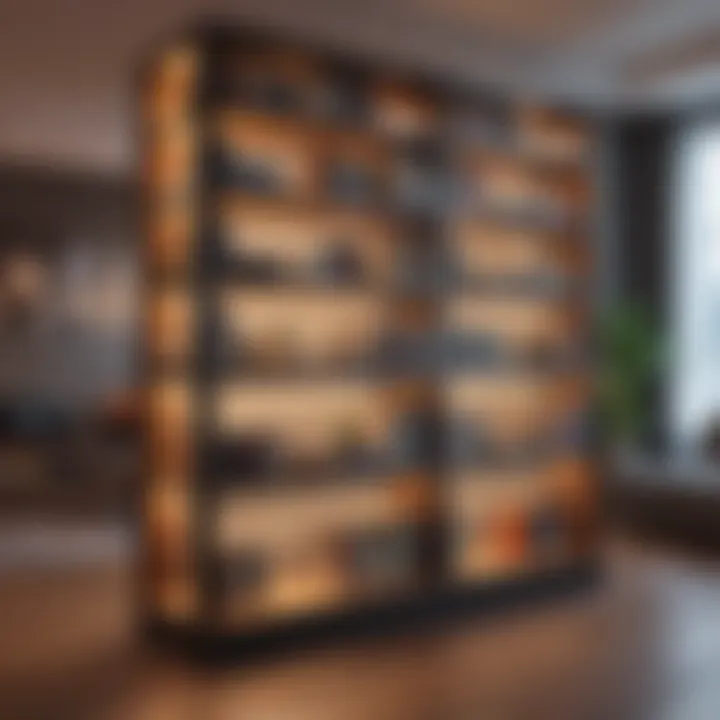
"Color and light are not just elements of design; they shape our experiences within a space."
In summary, by thoughtfully exploring color and light, homeowners and design enthusiasts can create separated yet cohesive environments that elevate daily living.
Incorporating Greenery
Incorporating greenery into a space is essential for various reasons. It serves both aesthetic and functional purposes in dividing rooms without walls. Plants can soften a room's appearance, creating a welcoming environment. When strategically placed, they can guide visual flow while still maintaining an open feel. Furthermore, having plants in your home can have significant health benefits, enhancing air quality and promoting overall well-being.
Using Plants as Natural Dividers
Plants can act as natural dividers, creating subtle boundaries without the need for physical barriers. This is particularly useful in open-plan spaces, where one might desire to separate areas for cooking, dining, or relaxing. Tall plants like Ficus elastica or Spathiphyllum can function well due to their height. They provide privacy while allowing light to pass through, thus maintaining an airy atmosphere.
Moreover, using varying heights and types of plants will create depth in your space. For instance, combining tall leafy plants with trailing varieties can establish layers, drawing the eye upward and across the room. An arrangement of plants in a single area can also be visually striking, signaling a distinct zone without imposing a wall.
Benefits of Indoor Plants for Space Separation
Choosing plants for indoor separation comes with numerous advantages. First, they contribute to better indoor air quality. Plants absorb pollutants and release oxygen. This improvement is crucial for maintaining a healthy living environment, especially in cities where outdoor air quality may be compromised.
Additionally, plants can enhance the mood of your space. Studies indicate that greenery can reduce stress levels and increase productivity. This element is particularly relevant for home offices or shared living spaces.
Other benefits include:
- Sound Absorption: Plants can help reduce noise, creating a quieter atmosphere.
- Humidity Regulation: Plants transpire, increasing humidity levels which can be beneficial for dry environments.
- Enhancing Aesthetics: A well-placed plant can elevate the visual appeal of a space, making it feel more alive.
Incorporating greenery into your design plan is a thoughtful way to divide spaces without sacrificing openness. It is important to consider light requirements and plant care when selecting the appropriate greenery for your environment.
"Plants are not just a decoration; they are an integral part of a living ecosystem within your home."
Integrating plants into your space divides helps achieve both beauty and purpose. By using natural elements wisely, you can redefine the boundaries in your home seamlessly.
Considering Outdoor Divisions
Outdoor divisions serve as an essential element in creating defined spaces within your property. They can significantly enhance both the aesthetic appeal of an area and its functionality. Knowing how to strategically incorporate outdoor divisions allows homeowners to optimize their spaces while adding a layer of privacy.
Considering outdoor divisions begins with understanding the environments we create. Outdoor spaces often blend different functions such as relaxation, entertainment, and gardening. Thus, defining these functions properly ensures that each activity can be enjoyed distinctly without disruptions.
Creating Privacy with Landscaping
Landscaping is one of the most effective methods to create privacy in outdoor spaces. By utilizing plants, trees, and shrubs, homeowners can establish visual barriers. Dense hedges or tall trees provide a natural screen, shielding areas from sight while still allowing natural light to filter through. This approach enhances outdoor comfort, making it easier for families or guests to enjoy their activities without feeling exposed.
Consider the following when using landscaping as a privacy solution:
- Plant Selection: Choose hardy plants that can grow tall and provide suitable coverage year-round.
- Layering: Use a mix of plants to create layers, providing both visual density and depth to the landscape.
- Seasonality: Incorporate evergreens for year-round privacy, while adding seasonal flowers for additional aesthetic appeal.
Employing landscaping effectively will not only enhance privacy but also contribute to the overall ecosystem.
Using Hardscapes to Define Outdoor Spaces
Hardscapes refer to the non-plant elements of landscaping, including walkways, patios, walls, and fences. They play a crucial role in outdoor divisions by providing structure and enhancing the usability of outdoor environments.
Employing hardscaping features can offer various benefits:
- Physical Boundaries: Solid structures like stone walls or wooden fences clearly mark different areas of your yard, separating cooking spaces from relaxation zones.
- Aesthetic Appeal: Materials used in hardscaping can complement your overall home design, making the outdoor area more visually cohesive.
- Durability: Hardscape elements are often more enduring than plant life, requiring less upkeep while remaining functional throughout seasons.
Integrating both landscaping and hardscaping will help in realizing an outdoor environment that feels cohesive and structured, fulfilling the needs of various activities while offering much-needed privacy.
Closure
The conclusion serves a vital role in reinforcing the narrative of this article on dividing rooms without using walls. It encapsulates the various methods discussed throughout, summarizing key points while emphasizing the continuous evolution in room design. The importance of recognizing the myriad options available cannot be overstated, since effective space division enhances both functionality and aesthetic appeal in our environments.
In an age where open living spaces are increasingly popular, homeowners, renters, and interior design enthusiasts benefit significantly from applying creativity and practicality in their approach to room layouts. The practical implementations range from strategic furniture arrangements to more innovative solutions, such as movable partitions and shelving, providing flexibility in adapting spaces as needs evolve.
The benefits reflect not only in the visual coherence of divided spaces but also in improved organization. It curates an environment that fosters productivity and comfort, ultimately enhancing the quality of life in shared areas. As featured earlier, multiple strategies and designs contribute to effective room division, allowing individuals to tailor their layout to fit specific purposes and personal styles.
Summarizing Key Points
As the article draws to a close, it is essential to synthesize the core messages:
- Diverse Division Techniques: There are many techniques for separating spaces, ranging from furniture and shelving to screens and curtains.
- Functional Versatility: Multi-functional furniture allows for flexibility in how spaces are used, promoting efficiency.
- Aesthetic Considerations: Color, light, and greenery play crucial roles in enhancing visual appeal and creating a harmonious environment.
- Future Insights: The shifts toward innovative design often lead to adaptable spaces, accommodating changing lifestyles.
Understanding how to effectively divide and optimize spaces is increasingly relevant as living conditions become more dynamic. Knowing the available options empowers individuals to create environments that reflect their personal needs and preferences.
Future Trends in Room Division
Looking ahead, one can anticipate further changes in how room division will be approached. As urban living becomes more prevalent and dwellings become smaller, solutions will continue to innovate:
- Increased Use of Digital Tools: Technology will allow better visualization and planning for room layouts, helping design more efficiently.
- Sustainability Focus: Growing awareness of environmental issues may lead to the use of eco-friendly materials in partitions and furniture.
- Enhanced Adaptability: Furniture designs will likely advance towards even greater flexibility, accommodating live-work spaces and multi-functional environments more seamlessly.
- Smart Home Integration: The use of smart technology in room division could streamline how spaces are managed and utilized, enhancing the overall user experience.
These emerging trends suggest that the principles of space division will continue to evolve, reflecting broader societal changes. The future promises innovative solutions that will cater to the needs of diverse lifestyles, ensuring effective and stylish adaptations in our living spaces.















